Submitted:
10 April 2024
Posted:
11 April 2024
You are already at the latest version
Abstract
Keywords:
1. Introduction
- How can the spread of dominant grass be controlled? Can mowing reduce C. epigejos coverage, and if so, how long does it take?
- How does the species number and diversity of the sward change during the experiment?
- Does the proportion of species important for grassland management change? If so, in what direction?
2. Materials and Methods
2.1. Study Area
2.2. Experimental Design and Data Collecting
- 4.
- 1. dominant grass species ie: C. epigejos
- 5.
- 2. subordinate grass species important for grassland management
- 6.
- 3. Fabaceae species important for grassland management
- 7.
- other Dicotyledonous species neutral for grassland management
- 8.
- prickly plants
- 9.
- litter
2.3. Statistical Analyses
3. Results
3.1. Effects of Mowing on the Cover of C. epigejos
3.2. Effects of Mowing on the Number of Species and Diversity
3.3. Effects of Mowing on Biomass Composition
4. Discussion
5. Conclusions
- In our 10-year experiment, we found significant impact of treatment on the abundance of C. epigejos, along with the changes in the order of importance of the main grassland species.
- With this study we confirmed our observation that the retraction of C. epigejos also occurs spontaneously in later stages of succession. Although C. epigejos began to decline spontaneously, its dominance without treatment remained for a longer period.
- Species richness increased faster in the case, when plots were mowed.
- Regular mowing can improve the biomass composition and forage value of secondary dry grasslands.
Author Contributions
Funding
Acknowledgments
Data Availability Statement
Nomenclature
Conflicts of Interest
References
- Molnár, Z.; Biró, M.; Bartha, S.; Fekete, G. Past trends, present state and future prospects of Hungarian forest-steppes. In Eurasian steppes. Ecological problems and livelihoods in a changing world. Werger, M.J.A. and Staalduinen, M.A. (Eds.). New York: Springer Science & Business Media, 2012, 6, 209–252. [Google Scholar]
- Dengler, J.; Janišová, M.; Török, P.; Wellstein, C. Biodiversity of Palaearctic grasslands: A synthesis. Agric. Ecosyst. Environ. 2014, 182, 1–14. [Google Scholar] [CrossRef]
- Willner, W.; Kuzemko, A.; Dengler, J.; Chytrý, M.; Bauer, N.; Becker, T.; Biţă-Nicolae, C.; Botta-Dukát, Z.; Čarni, A.; Csiky, J.; et al. A higher-level classification of the Pannonian and western Pontic steppe grasslands (Central and Eastern Europe). Appl. Veg. Sci. 2016, 20, 143–158. [Google Scholar] [CrossRef] [PubMed]
- Török, P.; Penksza, K.; Tóth, E.; Kelemen, A.; Sonkoly, J.; Tóthmérész, B. Vegetation type and grazing intensity jointly shape grazing effects on grassland biodiversity. Ecol. Evol. 2018, 8, 10326–10335. [Google Scholar] [CrossRef]
- Poschlod, P.; Wallis de Vries, M.F. The historical and socioeconomic perspective of calcareous grasslands–lessons from the distant and recent past. Biol. Conserv. 2002, 104, 361–376. [Google Scholar] [CrossRef]
- Ruprecht, E.; Szabó, A.; Enyedi, M.Z.; Dengler, J. Steppe-like grasslands in Transylvania (Romania): Characterisation and influence of management on species diversity and composition. Tuexenia 2009, 29, 353–368. [Google Scholar]
- Pärtel, M.; Bruun, H.H.; Sammul, M. Biodiversity in temperate European grasslands: Origin and conservation. Grassland science in Europe, 2005, 10 (1), 14.
- Newbold, T.; Hudson, L.N.; Hill, S.L.L.; Contu, S.; Lysenko, I.; Senior, R.A.; Börger, L.; Bennett, D.J.; Choimes, A.; Collen, B.; et al. Global effects of land use on local terrestrial biodiversity. Nature 2015, 520, 45. [Google Scholar] [CrossRef]
- Fiala, K.; Holub, P.; Sedláková, I.; Tůma, I.; Záhora, J.; Tesařová, M. Reasons and consequences of expansion of Calamagrostis epigejos in alluvial meadows of landscape affected by water control measures. Ekologia 2003, 22 (Suppl. S2), 242–252. [Google Scholar]
- Bartha, S. Composition, differentiation and dynamics in the forest steppe biome. In Slope Steppes, Loess Steppes and Forest Steppe Meadows in Hungary. Illyés, E.; Bölöni, J. Eds. Budapest, Hungary: MTA ÖBKI ISBN: 978-963-06-3673-5; 2007; pp. 194–211.
- Virágh, K.; Horváth, A.; Bartha, S.; Somodi, I. A multi scale methodological approach novel in monitoring the effectiveness of grassland management. Commun. Ecol. 2008, 9, 237–246. [Google Scholar] [CrossRef]
- Díaz, S.; Settele, J.; Brondízio, E.S.; Ngo, H.T.; Agard, J.; Arneth, A.; Balvanera, P.; Brauman, K.A.; Butchart, S.H.M.; Chan, K.M.A.; et al. Pervasive human-driven decline of life on Earth points to the need for transformative change. Science 2019, 366, 1327. [Google Scholar] [CrossRef]
- Lindborg, R. Recreating Grasslands in Swedish Rural Landscapes – Effects of Seed Sowing and Management History. Biodivers. Conserv. 2005, 15, 957–969. [Google Scholar] [CrossRef]
- Mendenhall, C.D.; Karp, D.S.; Meyer, C.F.J.; Hadly, E.A.; Daily, G.C. Predicting biodiversity change and averting collapse in agricultural landscapes. Nature 2014, 509, 213–217. [Google Scholar] [CrossRef] [PubMed]
- Liu, D.; Semenchuk, P.; Essl, F.; Lenzner, B.; Moser, D.; Blackburn, T.M.; Cassey, P.; Biancolini, D.; Capinha, C.; Dawson, W.; et al. The impact of land use on non-native species incidence and number in local assemblages worldwide. Nat. Commun. 2023, 14, 1–11. [Google Scholar] [CrossRef] [PubMed]
- Jendrisakova, S.; Kováčiková, Z.; Vargová, V.; Michalec, M. The impact of cattle and sheep grazing on grassland in Veľká Fatra National Park. J. Water Land Dev. 2011, 15, 61–67. [Google Scholar] [CrossRef]
- Kuzmanović, N.; Šinžar-Sekulić, J.; Lakušić, D. Leaf anatomy of the Sesleria rigida Heuffel ex Reichenb. (Poaceae) in Serbia. Botanica Serbica 2009, 33 (1), 51-67.
- Bonanomi, G.; Incerti, G.; Allegrezza, M. Assessing the impact of land abandonment, nitrogen enrichment and fairy-ring fungi on plant diversity of Mediterranean grasslands. Biodivers. Conserv. 2013, 22, 2285–2304. [Google Scholar] [CrossRef]
- Tardella, F.M.; Malatesta, L.; Goia, I.G.; Catorci, A. Effects of long-term mowing on coenological composition and recovery routes of a Brachypodium rupestre-invaded community: Insight into the restoration of sub-Mediterranean productive grasslands. Rendiconti Lince- Sci. Fis. e Nat. 2018, 29, 329–341. [Google Scholar] [CrossRef]
- Hejcman, M.; Češková, M.; Schellberg, J.; Pätzold, S. The Rengen Grassland Experiment: Effect of Soil Chemical Properties on Biomass Production, Plant Species Composition and Species Richness. Folia Geobot. 2010, 45, 125–142. [Google Scholar] [CrossRef]
- Catorci, A.; Ottaviani, G.; Ballelli, S.; Cesaretti, S. Functional differentiation of Central Apennine grasslands under mowing and grazing disturbance regimes. Pol. J. Ecol. 2011, 59, 115–128. [Google Scholar]
- Szentes, S.; Sutyinszki, Z.; Szabó, G.; Zimmermann, Z.; Járdi, I.; Házi, J.; Bartha, S.; Penksza, K. Studies on the effects of old world bluestem (Bothriochloa ischaemum (L. ) Keng 1936) on species composition of grassland with microcoenological methods. Anim. Welf. Ethol. Hous. Syst. 2012, 8, 88–102. [Google Scholar]
- Rebele, F. Calamagrostis epigejos (L. ) Roth auf anthropogenen Standorten–ein Überblick. Verh. Der Ges. Für Okol. 1996, 26, 753–763. [Google Scholar]
- Rebele, F.; Lehmann, C. Biological Flora of Central Europe: Calamagrostis epigejos (L.) Roth. Flora 2001, 196, 325–344. [Google Scholar] [CrossRef]
- Gloser, V.; Košvancová, M.; Gloser, J. Changes in growth parameters and content of N-storage compounds in roots and rhizomes of Calamagrostis epigejos after repeated defoliation. Biol. Bratisl. 2004, 59, 179–184. [Google Scholar]
- Prach, K.; Pyšek, P. Using spontaneous succession for restoration of human-disturbed habitats: Experience from Central Europe. Ecol. Eng. 2001, 17, 55–62. [Google Scholar] [CrossRef]
- Huhta, A.; Pasi, R.; Tuomi, J.; Laine, K. Restorative mowing on an abandoned semi-natural meadow: Short-term and predicted long-term effects. J. Veg. Sci. 2001, 12, 677–686. [Google Scholar] [CrossRef]
- Sedláková, I.; Fiala, K. Ecological degradation of alluvial meadows due to expanding Calamagrostis epigejos. Ekologia 2001, 20 (Suppl. S3), 226–333. [Google Scholar]
- Kompała-Bąba, A.; Sierka, E.; Dyderski, M.K.; Bierza, W.; Magurno, F.; Besenyei, L.; Błońska, A.; Ryś, K.; Jagodziński, A.M.; Woźniak, G. Do the dominant plant species impact the substrate and vegetation composition of post-coal mining spoil heaps? Ecol. Eng. 2019, 143, 105685. [Google Scholar] [CrossRef]
- Zhukovskaya, O.V.; Ulanova, N.G. Influence of brushing frequency on birch population structure after felling. Écoscience 2006, 13, 219–225. [Google Scholar] [CrossRef]
- Csontos, P. Light ecology and regeneration on clearings of sessile oak-Turkey oak forests in the Visegrád Mountains, Hungary. Acta Bot. Hung. 2010, 52, 265–286. [Google Scholar] [CrossRef]
- Fiala, K.; Tůma, I.; Holub, P. Effect of nitrogen addition and drought on above-ground biomass of expanding tall grasses Calamagrostis epigejos and Arrhenatherum elatius. Biologia 2011, 66, 275–281. [Google Scholar] [CrossRef]
- Błońska, E.; Kempf, M.; Lasota, J. Woody debris as a substrate for the growth of a new generation of forest trees. For. Ecol. Manag. 2022, 525. [Google Scholar] [CrossRef]
- Prach, K. Succession of vegetation on dumps from strip coal mining, N. W. Bohemia, Czechoslovakia. Folia Geobot. et Phytotaxon. 1987, 22, 339–354. [Google Scholar] [CrossRef]
- Bartha, S. Preliminary scaling for multi-species coalitions in primary succession. Abstr. Bot. 1992, 16, 31–41. [Google Scholar]
- Baasch, A.; Tischew, S.; Bruelheide, H. Twelve years of succession on sandy substrates in a post-mining landscape: A Markov chain analysis. Ecol. Appl. 2010, 20, 1136–1147. [Google Scholar] [CrossRef] [PubMed]
- Hultén E, Fries M. Atlas of North European vascular plants: North of theTropic of Cancer I-III. 1986, Koeltz Scientific Books, Königstein,.
- Csecserits, A.; Rédei, T. Secondary succession on sandy old-fields in Hungary. Appl. Veg. Sci. 2001, 4, 63–74. [Google Scholar] [CrossRef]
- Bartha, S.; Szentes, S.; Horváth, A.; Házi, J.; Zimmermann, Z.; Molnár, C.; Dancza, I.; Margóczi, K.; Pál, R.W.; Purger, D.; et al. Impact of mid-successional dominant species on the diversity and progress of succession in regenerating temperate grasslands. Appl. Veg. Sci. 2013, 17, 201–213. [Google Scholar] [CrossRef]
- Rothmaler,W. Exkursionsflora von Deutschland. Aufl. n Volk und Wissen Verlag. Berlin,1988, Bd. 3. n 7.
- Hajnáczki, S.; Pajor, F.; Péter, N.; Bodnár. ; Penksza, K.; Póti, P. Solidago gigantea Ait. and Calamagrostis epigejos (L) Roth invasive plants as potential forage for goats. Not. Bot. Horti Agrobot. Cluj-Napoca 2021, 49, 12197. [Google Scholar] [CrossRef]
- Marosi, S.; Somogyi, S. (Eds.) Magyarország Kistájainak Katasztere (Cadastral of Microregions of Hungary); MTA Földrajztudományi Kutatóintézet: Budapest, Hungary, 1991; pp. 379–388. [Google Scholar]
- Borhidi, A.; Kevey, B.; Lendvai, G. Plant communities of Hungary. Akadémiai Kiadó, Budapest, Hungary, 2012, 544 pp.
- European Environment Agency. 6250 Pannonic loess steppic grasslands. Report under the Article 17 of the Habitats Directive Period 2007-2012 Available online:. Available online: https://eunis.eea.europa.eu/habitats/10124#sites (accessed on 20 December 2022).
- Házi, J.; Bartha, S.; Szentes, S.; Wichmann, B.; Penksza, K. ; Seminatural grassland management by long-term mowing of Calamagrostis epigejos in western Cserhát, Hungary (Management sekundärer Trockenrasen durch Langzeit-Mahd von Calamagrostis epigejos im westlichen Cserhát, Ungarn). In. Steppenlebensräume Europas–Gefährdung, Erhaltungsmassnahmen und Schutz; Thüringer Ministerium für Landwirtschaft, Forsten, Umwelt und Naturschutz (TMLFUN), Erfurt, ISBN 978-3-00-044248-3. Baumbach, H., Pfützenreuter, S. (eds.); 2013; pp. 331–340.
- Házi, J.; Bartha, S.; Szentes, S.; Wichmann, B.; Penksza, K. Seminatural grassland management by mowing of Calamagrostis epigejos in Hungary. Plant Biosyst. 2011, 145, 699–707. [Google Scholar] [CrossRef]
- Md. Nazmul Islam, Kusay Faisal Al-tabatabaie, Md. Ahasan Habib, Sheikh Sharif Iqbal, Khurram Karim Qureshi and Eid M. Al-Mutairi, Design of a Hollow-Core Photonic Crystal Fiber Based Edible Oil Sensor, Crystals 2022, 7, 101. [CrossRef]
- R Core Team. R: A Language and Environment for Statistical Computing; R Foundation for Statistical Computing, Vienna, Austria, 2013, ISBN 3-900051-07-0. Available online: http://www.R-project.org/ (accessed on 20 February 2018).
- Hammer, Ø.; Harper, D.A.T.; Ryan, P.D. PAST: Paleontological Statistics software package for education and data analysis. Palaeontol. Electron. 2001, 4, 9. [Google Scholar]
- Klimeš, L.; Klimešova, J. The effects of mowing and fertilisation on carbohydrate reserves and regrowth of grasses: Do they promote plant coexistence in species-rich meadows? Evol Ecol 2002, 15, 363–382. [Google Scholar] [CrossRef]
- Kavanová, M.; Gloser, V. The Use of Internal Nitrogen Stores in the Rhizomatous Grass Calamagrostis epigejos During Regrowth After Defoliation. Ann. Bot. 2004, 95, 457–463. [Google Scholar] [CrossRef] [PubMed]
- Prach, K. Succession of vegetation on dumps from strip coal mining, N. W. Bohemia, Czechoslovakia. Folia Geobot. et Phytotaxon. 1987, 22, 339–354. [Google Scholar] [CrossRef]
- Bartha, S. Preliminary scaling for multi-species coalitions in primary succession. Abstr. Bot. 1992, 16, 31–41. [Google Scholar]
- Gerwin, W.; Raab, T.; Birkhofer, K.; Hinz, C.; Letmathe, P.; Leuchner, M.; Roß-Nickoll, M.; Rüde, T.; Trachte, K.; Wätzold, F.; et al. Perspectives of lignite post-mining landscapes under changing environmental conditions: What can we learn from a comparison between the Rhenish and Lusatian region in Germany? Environ. Sci. Eur. 2023, 35, 1–24. [Google Scholar] [CrossRef]
- Bobbink, R.; During, H.J.; Schreurs, J.; Willems, J.; Zielman, R. Effects of selective clipping and mowing time on species diversity in chalk grassland. Folia Geobot. et Phytotaxon. 1987, 22, 363–376. [Google Scholar] [CrossRef]
- Bobbink, R.; Willems, J. Impact of different cutting regimes on the performance of Brachypodium pinnatum in Dutch chalk grassland. Biol. Conserv. 1991, 56, 1–21. [Google Scholar] [CrossRef]
- Fenner, M. & Palmer, L. Grassland management to promote diversity: Creation of patchy sward by mowing and fertiliser regimes. Field Studies 1998, 9: 313–324.
- Valkó, O.; Zmihorski, M.; Biurrun, I.; Loos, J.; Labadessa, R.; Venn, S. Ecology and Conservation of Steppes and Semi-Natural Grasslands. Hacquetia 2016, 15, 5–14. [Google Scholar] [CrossRef]
- Sierka, E.; Kopczynska, S. Participation of Calamagrostis epigejos (L. ) Roth in plant communities of the River Bytomka valley in terms of its biomass use in power industry. Environ. Socio-Econ. Stud. 2014, 2, 38–44. [Google Scholar]
- Neuhaus, Ryan Allan, "A comparison of the effects of burning, haying and mowing on plants and small mammals in a tallgrass prairie reconstruction" (2015). Dissertations and Theses @ UNI. 216. https://scholarworks.uni.edu/etd/216.
- Tardella, F.M.; Bricca, A.; Piermarteri, K.; Postiglione, N.; Catorci, A. Context-dependent variation of SLA and plant height of a dominant, invasive tall grass (Brachypodium genuense) in sub-Mediterranean grasslands. Flora 2017, 229, 116–123. [Google Scholar] [CrossRef]
- Oelmann, Y.; Broll, G.; Hölzel, N.; Kleinebecker, T.; Vogel, A.; Schwartze, P. Nutrient impoverishment and limitation of productivity after 20 years of conservation management in wet grasslands of north-western Germany. Biol. Conserv. 2009, 142, 2941–2948. [Google Scholar] [CrossRef]
- Szépligeti, M.; Kőrösi, Á.; Szentirmai, I.; Házi, J.; Bartha, D.; Bartha, S. Evaluating alternative mowing regimes for conservation management of Central European mesic hay meadows: A field experiment. Plant Biosyst. - Int. J. Deal. all Asp. Plant Biol. 2018, 152, 90–97. [Google Scholar] [CrossRef]
- Piseddu, F.; Bellocchi, G.; Picon-Cochard, C. Mowing and warming effects on grassland species richness and harvested biomass: Meta-analyses. Agron. Sustain. Dev. 2021, 41, 1–21. [Google Scholar] [CrossRef]
- Sheil, D.; Burslem, D.F. Defining and defending Connell's intermediate disturbance hypothesis: A response to Fox. Trends Ecol. Evol. 2013, 28, 571–572. [Google Scholar] [CrossRef] [PubMed]
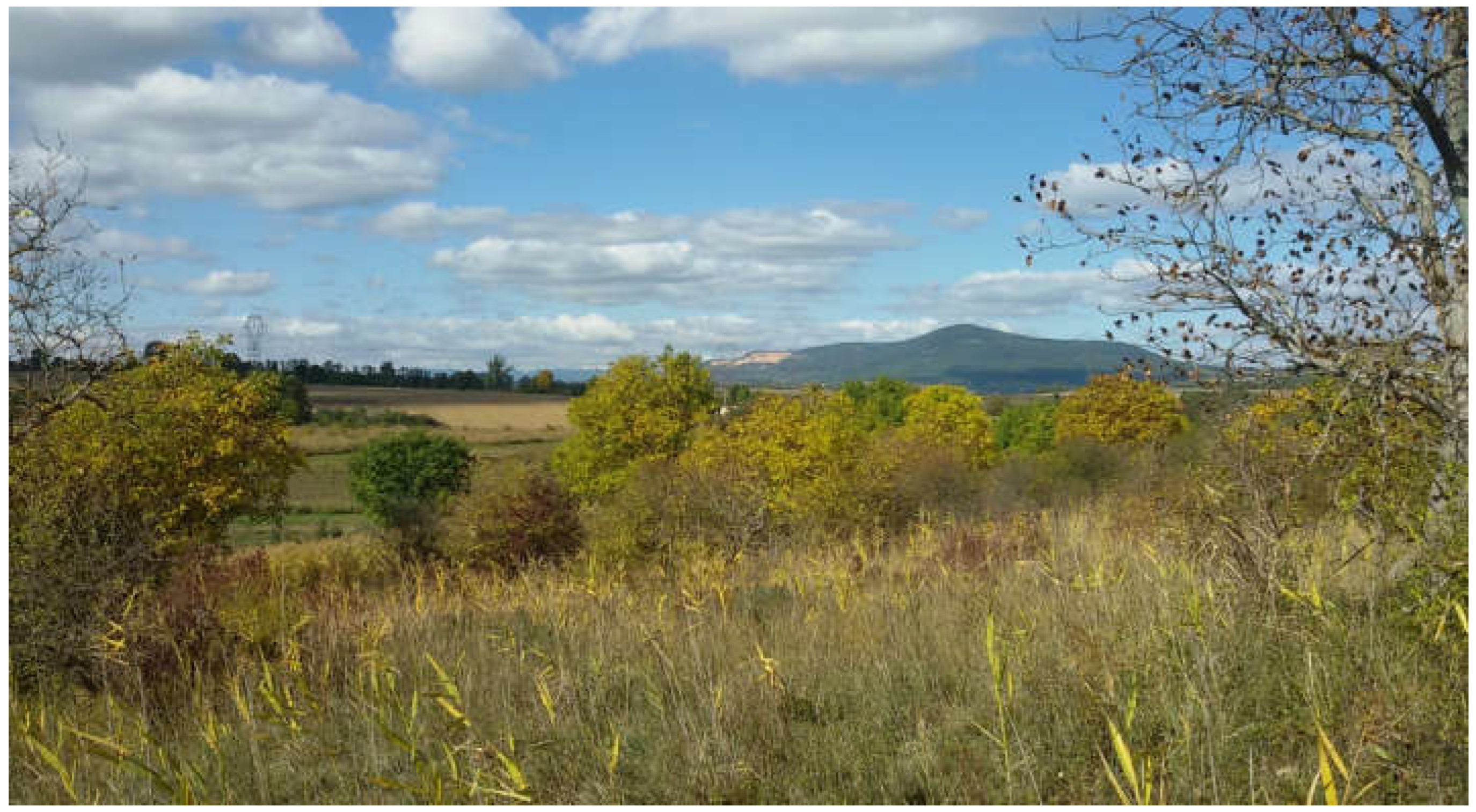
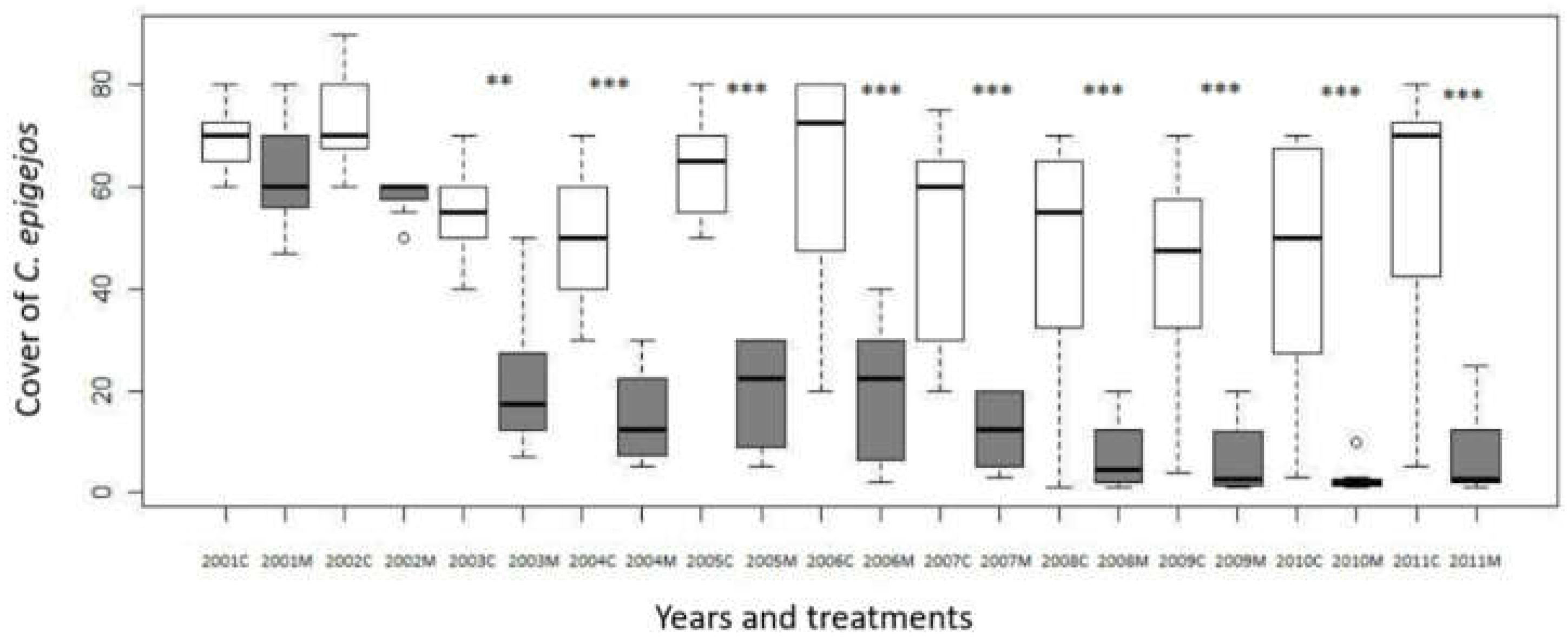
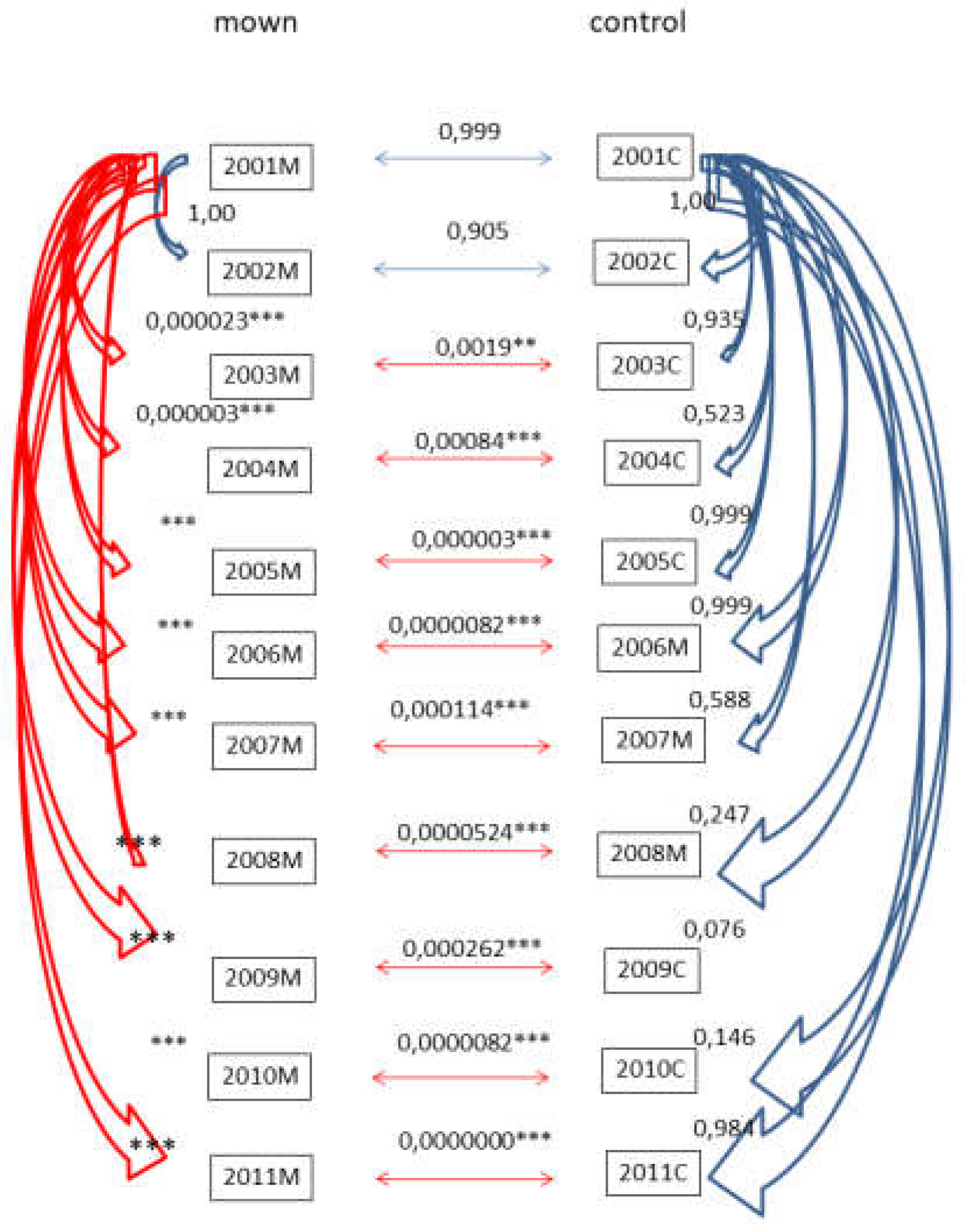
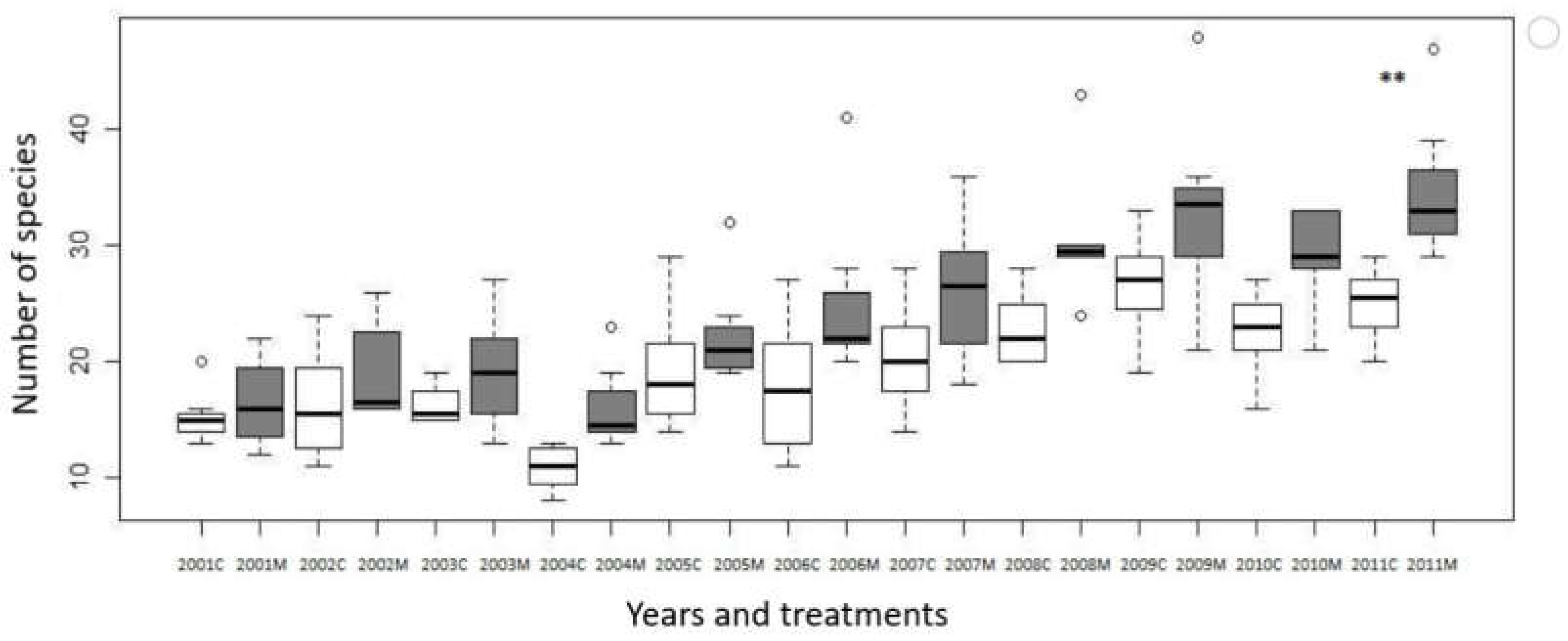
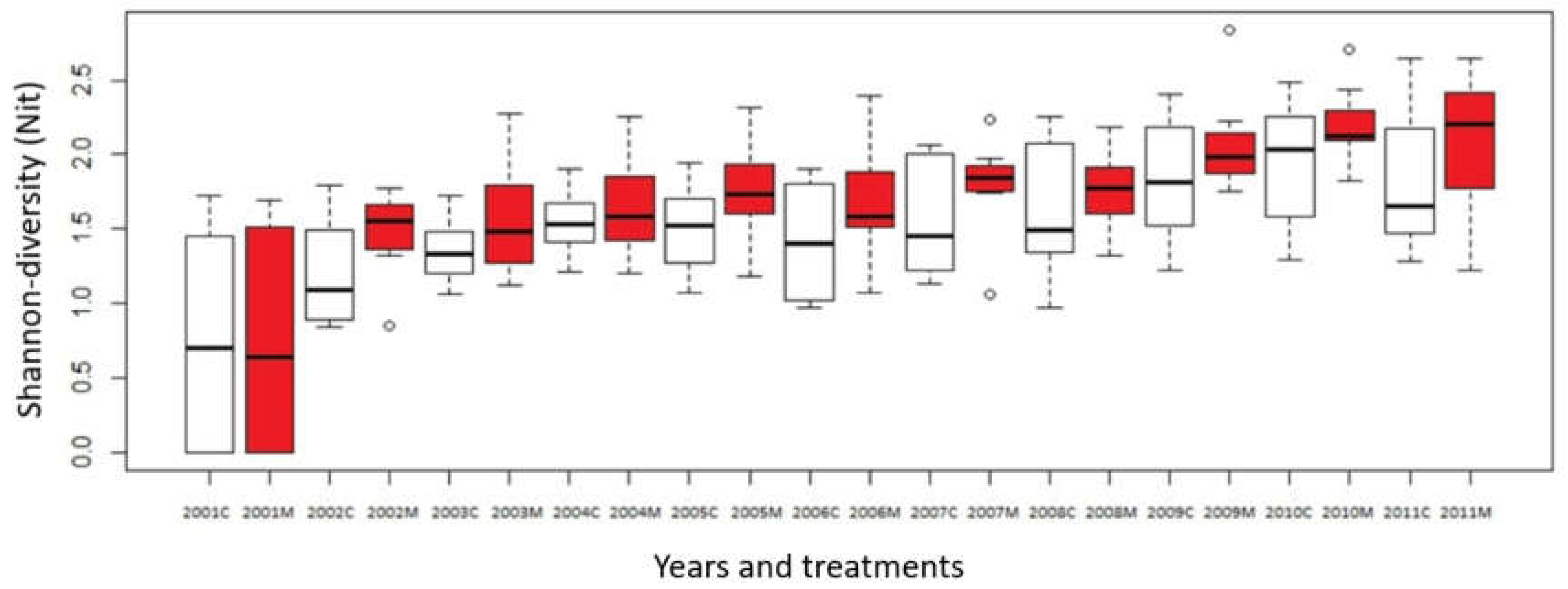
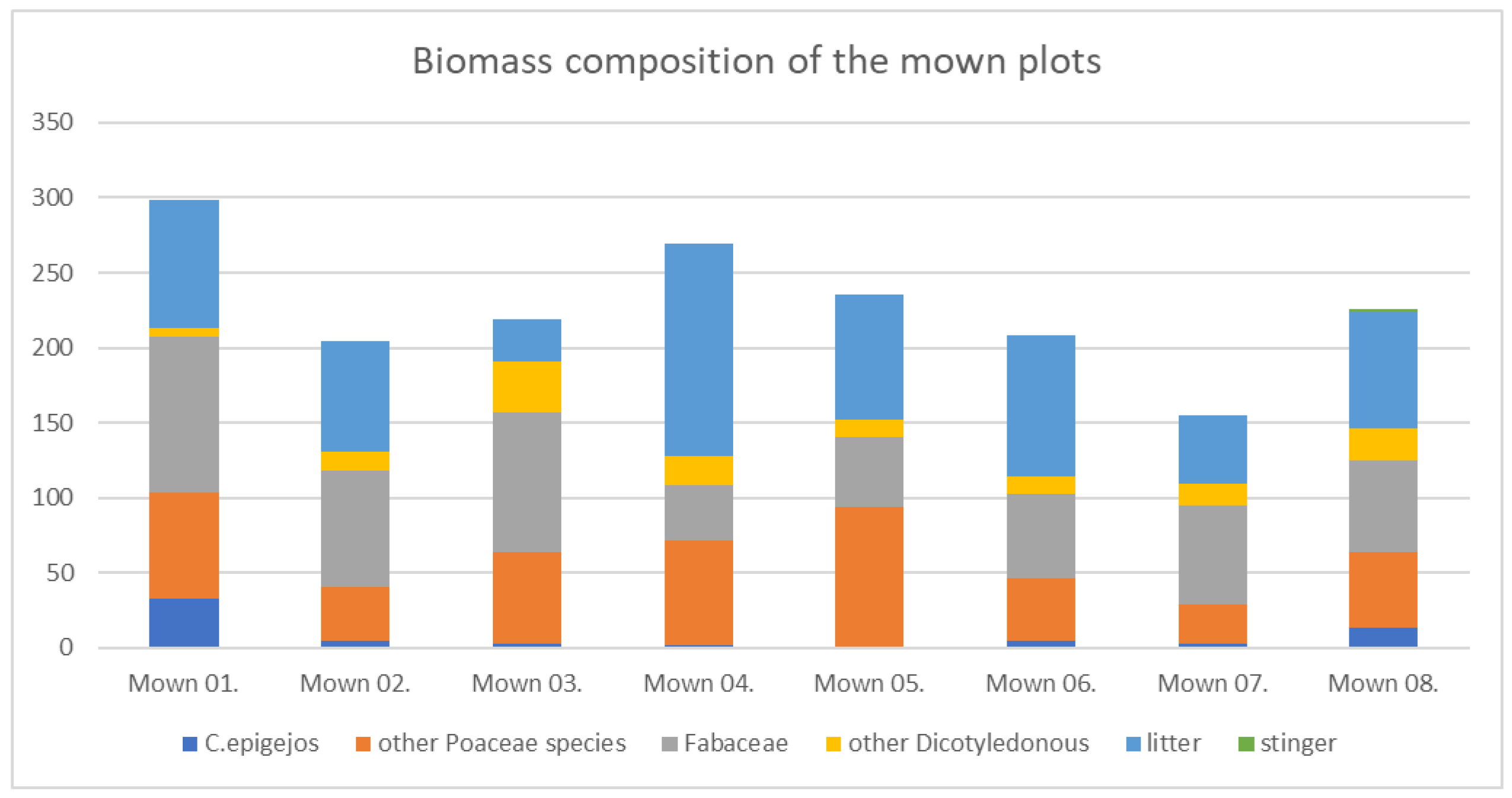
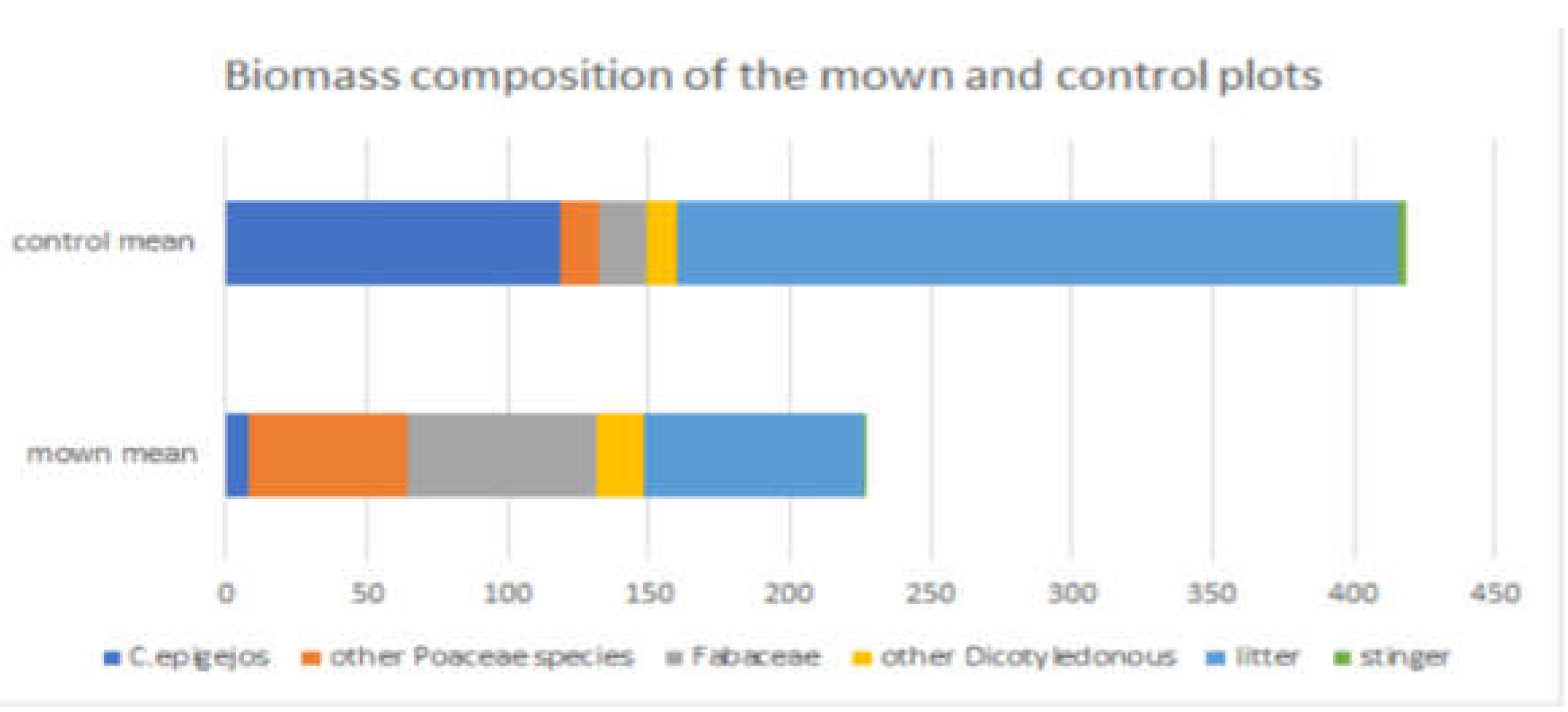
| MOWN | CONTROL | |||||||||||
| 2001 | 2006 | 2011 | 2001 | 2006 | 2011 | |||||||
| Mean | Mean | Mean | Mean | Mean | Mean | |||||||
| Total cover absolute | 95,54 | 102,18 | 111,91 | 108,09 | 108,03 | 111,71 | ||||||
| Cover of C. epigejos absolute | 62,38 | 20,00 | 7,50 | 69,38 | 62,50 | 56,88 | ||||||
| Cover of C. epigejos relative | 0,65 | 0,19 | 0,06 | 0,64 | 0,58 | 0,51 | ||||||
| Cover of subordinated species absolute | 33,16 | 82,18 | 104,41 | 38,71 | 45,53 | 54,84 | ||||||
| Cover of subordinated species relative | 0,35 | 0,81 | 0,94 | 0,36 | 0,42 | 0,49 | ||||||
| Number of species | 16,50 | 25,00 | 34,63 | 15,25 | 17,75 | 25,00 |
Disclaimer/Publisher’s Note: The statements, opinions and data contained in all publications are solely those of the individual author(s) and contributor(s) and not of MDPI and/or the editor(s). MDPI and/or the editor(s) disclaim responsibility for any injury to people or property resulting from any ideas, methods, instructions or products referred to in the content. |
© 2024 by the authors. Licensee MDPI, Basel, Switzerland. This article is an open access article distributed under the terms and conditions of the Creative Commons Attribution (CC BY) license (https://creativecommons.org/licenses/by/4.0/).





